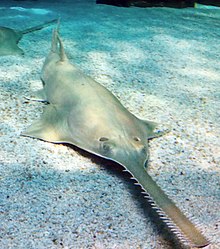Pristis
| Pristis | |
|---|---|

| |
| Pristis pristis | |

| |
| Pristis zijsron | |
| Scientific classification | |
| Kingdom: | Animalia |
| Phylum: | Chordata |
| Class: | Chondrichthyes |
| Order: | Rhinopristiformes |
| Family: | Pristidae |
| Genus: | Pristis Linck, 1790 |
Pristis is a genus of sawfish of the family Pristidae. These large fish are found worldwide in tropical and subtropical regions in coastal marine waters, estuaries, and freshwater lakes and rivers.[3] Sawfish have declined drastically and all species are considered seriously threatened today.[4][5]
Taxonomy[]
The scientific genus name Pristis is derived from the Greek word for saw.[6]
Living species[]
Recent authorities recognize four species:[4][5][7][8]
- Pristis clavata Garman, 1906 — dwarf sawfish, Queensland sawfish
- Pristis pectinata Latham, 1794 — smalltooth sawfish
- Pristis pristis (Linnaeus, 1758) — largetooth sawfish, common sawfish, freshwater sawfish, Leichhardt's sawfish
- Pristis zijsron Bleeker, 1851 — longcomb sawfish, green sawfish
These are divided into two species groups. Most are considered a part of the smalltooth group, except P. pristis which is the sole member of the largetooth group.[9] Two additional species, P. microdon and P. perotteti, have historically been recognized, but in 2013 it was shown that they are conspecific with P. pristis as morphological and genetic differences are lacking,[9] leading recent authorities to treat them as synonyms.[5][7][8][10][11][12] Anoxypristis cuspidata was formerly included in Pristis, but it has a number of distinctive features (for example, no teeth on the basal quarter of the saw) and recent authorities place it in its own genus.[3][5][7]
Extinct species[]
According to Fossilworks, extinct Pristis species only known from fossil remains include:[13]
- Agassiz 1843
- Cope 1869
- Pristis aquitanicus Delfortrie 1871
- Zbyszewski 1947
- Agassiz 1843
- Cope 1869
- Casier 1949
- Dartevelle and Casier 1959
- Dixon 1850
- Leidy 1855
- Münster 1846
- Leidy 1855
- Stromer 1905
- Agassiz 1843
- Jonet 1968
- Pristis lathami Galeotti 1837
- Dartevelle and Casier 1959
- Latham 1794
- Case 1981
- Stromer 1905

However, among this list are some species considered invalid by recent authorities and others now generally recognized as belonging in Anoxypristis.[1][14][15] Fossil Pristis range from the Late Paleocene to the Quaternary period.[1][2] Fossils have been found all over the world.[13]
References[]
- ^ a b c Wueringer, B.E.; L. Squire Jr.; S.P. Collin (2009). "The biology of extinct and extant sawfish (Batoidea: Sclerorhynchidae and Pristidae)". Rev Fish Biol Fisheries. 19 (4): 445–464. doi:10.1007/s11160-009-9112-7. S2CID 3352391.
- ^ a b Cicimurri, D.J. (2009). "A Partial Rostrum of the Sawfish Pristis lathami Galeotti, 1837, from the Eocene of South Carolina". Journal of Paleontology. 81 (3): 597–601. doi:10.1666/05086.1. S2CID 130683481.
- ^ a b Last; White; de Carvalho; Séret; Stehmann; and Naylor (2016). Rays of the World. CSIRO. pp. 59–66. ISBN 9780643109148.CS1 maint: uses authors parameter (link)
- ^ a b "Pristis". International Union for Conservation of Nature, Red List of Threatened Species. 14 November 2017. Retrieved 14 November 2017.
- ^ a b c d Dulvy; Davidson; Kyne; Simpfendorfer; Harrison; Carlson; and Fordham (2014). "Ghosts of the coast: global extinction risk and conservation of sawfishes" (PDF). Aquatic Conserv: Mar. Freshw. Ecosyst. 26 (1): 134–153. doi:10.1002/aqc.2525.CS1 maint: uses authors parameter (link)
- ^ Sullivan, T.; C. Elenberger (April 2012). "Largetooth Sawfish". University of Florida. Retrieved 14 November 2017.
- ^ a b c Eschmeyer, W.N.; R. Fricke; R. van der Laan (1 November 2017). "Catalog of Fishes". California Academy of Sciences. Retrieved 14 November 2017.
- ^ a b Last, P.R.; De Carvalho, M.R.; Corrigan, S.; Naylor, G.J.P.; Séret, B.; Yang, L. (2016). "The Rays of the World project - an explanation of nomenclatural decisions". In Last, P.R.; Yearsley, G.R. (eds.). Rays of the World: Supplementary Information. CSIRO Special Publication. pp. 1–10. ISBN 9781486308019.
- ^ a b Faria, V. V.; McDavitt, M. T.; Charvet, P.; Wiley, T. R.; Simpfendorfer, C. A.; Naylor, G. J. P. (2013). Species delineation and global population structure of Critically Endangered sawfishes (Pristidae). Zoological Journal of the Linnean Society 167: 136–164. doi:10.1111/j.1096-3642.2012.00872.x.
- ^ Kyne, P.M.; Carlson, J. & Smith, K. (2013). "Pristis pristis". The IUCN Red List of Threatened Species. IUCN. 2013: e.T18584848A18620395. doi:10.2305/IUCN.UK.2013-1.RLTS.T18584848A18620395.en.
- ^ Department of the Environment (2017). "Pristis pristis — Freshwater Sawfish, Largetooth Sawfish, River Sawfish, Leichhardt's Sawfish, Northern Sawfish". Department of the Environment and Energy. Retrieved 14 November 2017.CS1 maint: uses authors parameter (link)
- ^ Pollerspöck, J.; N. Straube. "Pristis pristis". shark-references.com. Retrieved 14 November 2017.
- ^ a b Fossilworks
- ^ Van Oljen; Faria; and McDavitt (2007). "The curious holotype of Pristis dubius Bleeker, 1852 and the unravelling of Bleeker's sawfish taxonomy". Raffles Bulletin of Zoology. 14: 37–49. doi:10.1007/s11160-009-9112-7. S2CID 3352391.CS1 maint: uses authors parameter (link)
- ^ "Introduction". Fossil Sawfish. Retrieved 17 November 2017.
![]() Media related to Pristis at Wikimedia Commons
Media related to Pristis at Wikimedia Commons
- Pristis
- Marine fish genera